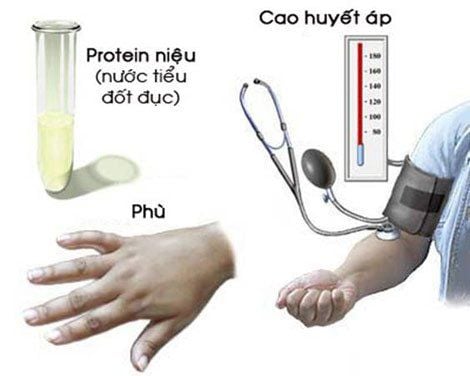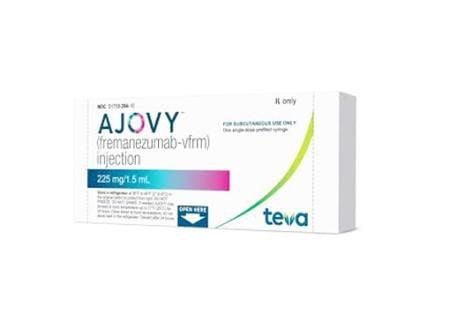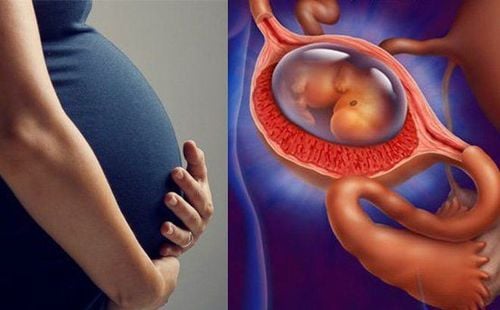This is an automatically translated article.
The article is professionally advised by: Master. Do Thi Hoang Ha - Doctor of Biochemistry - Laboratory Department, Vinmec Hai Phong General HospitalPreeclampsia is a serious systemic pregnancy syndrome during pregnancy, which is the cause of many obstetric complications, and especially can threaten the life of both the mother and the fetus.
1. What is preeclampsia?
Preeclampsia (also known as toxemia of pregnancy) is a serious disorder that usually develops after the 20th week of pregnancy, characterized by symptoms such as edema, high blood pressure, and increased levels of protein in the urine. .
Preeclampsia is extremely dangerous because it causes many serious consequences for both mother and fetus:
Complications for the mother: Complications in the central nervous system: cerebral edema, eclampsia, cerebral hemorrhage - meningitis. Eye complications: blindness due to the effects of retinal edema, cerebral edema, arterial spasm. Renal complications: acute tubular necrosis, acute renal failure. Hepatic complications: subcapsular hemorrhage, possible rupture of the liver, intra-abdominal bleeding, liver failure. Cardiac complications: acute heart failure. Pulmonary complications: acute pulmonary edema may occur (seen in severe preeclampsia). Complications of coagulation disorders: thrombocytopenia, disseminated coagulation in the blood vessels. Chronic hypertension, chronic nephritis. Complications for the fetus: Intrauterine growth retardation (more than 50%) Intrauterine stillbirth. Premature birth (40%) due to severe pre-eclampsia Perinatal mortality (10%): perinatal mortality is increased if there are complications of placental abruption, premature delivery. In addition, preeclampsia can progress as severe and rapidly as progression to HELLP syndrome occurs. This syndrome includes: hemolysis, elevated liver enzymes (Elevated liver enzymes), and low platelets.

2. Is there any way to detect preeclampsia early?
Previously, preeclampsia was diagnosed mainly based on classic clinical symptoms such as edema, hypertension, and proteinuria, and was diagnosed as early as 20 weeks of pregnancy. However, in the face of dangerous complications caused by preeclampsia, the need for a new method to diagnose preeclampsia has become increasingly necessary.
Recently, two factors of particular interest are PLGF and sFlt-1. PlGF (Placental Growth Factor - placental growth factor, also known as angiogenic factor) plays an important role in placental angiogenesis, while sFlt-1 (soluble fms - like tyrosine kinase 1- soluble tyrosine kinase 1 analogous to fms)) is a soluble endothelial growth factor receptor with antiangiogenic activity. Studies have shown that in the blood of pregnant women with preeclampsia, PlGF and sFlt-1 change quite early before the onset of clinical symptoms.
In normal pregnant women, PLGF and sFlt-1 levels change over the gestational age as follows: PLGF gradually increases and peaks in mid-pregnancy and then declines until before delivery, while sFlt-1 is similar is relatively stable in early pregnancy and increases in late pregnancy.
For pregnant women at risk of pre-eclampsia, the concentration of sFlt-1 increased in the blood of pregnant women, in contrast, the concentration of PLGF decreased compared with normal pregnant women of the corresponding gestational age. Therefore, it is possible to quantify PLGF, sFlt-1 levels and calculate the sFlt-1/PLGF ratio for early diagnosis of preeclampsia from week 12 of pregnancy (ie, preeclampsia can be detected as early as pregnancy). the first 3 months ).

Finding an association between PLGF and sFlt-1 in preeclampsia is of great importance. Pregnant women can now detect pre-eclampsia early so that they can have timely treatment, avoiding unfortunate complications that can happen to both the mother and the fetus.
With the desire to bring future mothers comprehensive and safe care for mother and fetus during the process of before - during - after birth, Vinmec International General Hospital with the facility is equipped with Vietnam's leading modern investment, a team of experienced experts deploying all-inclusive maternity services integrating all necessary examination and testing processes.
Quantitative angiogenesis factor test in the 12-week Maternity Package can make pregnant women completely reassured about the fear of pre-eclampsia.
Customers can directly go to Vinmec Health system nationwide to register for the package maternity care program or contact the hospitals and clinics of Vinmec Health system nationwide
Please dial HOTLINE for more information or register for an appointment HERE. Download MyVinmec app to make appointments faster and to manage your bookings easily.














